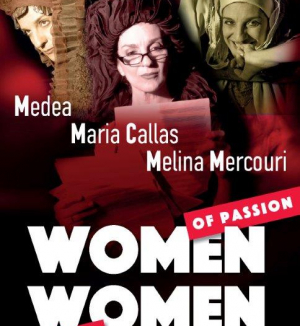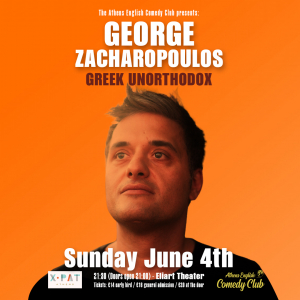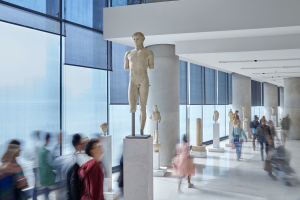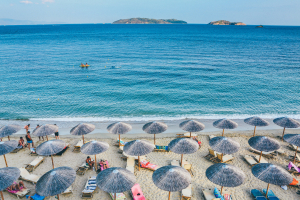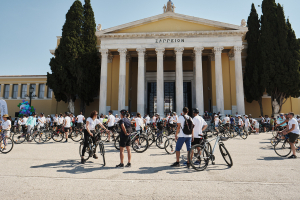BUSINESS CENTRE
XpatAthens
Summer Kids Camp In Technopolis
Designed for children aged 6-11, this camp offers a unique and unforgettable summer program filled with creativity and fun. Running from June 19th to July 14th, the camp provides a rich educational schedule in collaboration with Artfygio, a visual arts workshop. From Monday to Friday, between 8:00 AM and 4:00 PM, children will engage in various activities such as educational programs, innovative workshops, theatrical games, and performances created by the kids themselves.
The camp draws inspiration from the primary colors of light, including refreshing green, cool blue, vibrant red, and bright white. Divided into four themed weeks, it promises cool ideas and exciting experiences.
Children can participate in STEAM art workshops, dance classes, board games for all ages, group sports in the courtyard, educational city tours in Athens, and other incredible activities. Let your children's summer be filled with creativity at the Summer Camp in Technopolis!
The Memory of Water by Shelagh Stephenson
“Il Giardino Segreto” in the Atrium of Alexander’s Lounge
Women of Passion, Women of Greece
Every Saturday at 19:15 hrs (as of 27 May 2023) for 10 performances only (29/7)
The show may be followed by dinner in the Wagon Restaurant or at the open-air Bar & Restaurant “Apovathra” (dishes from 6€ / glass of wine 5€ / spirits 7,5€)Athens English Comedy Club Presents: George Zacharopoulos | Greek Unorthodox |
Buy tickets HERE!
Tickets:
* Early-bird (til May 28th) : €14
* General admission (after May 28th): €16
* At the door: €20
We also offer 3 free tickets per show to persons with disabilities or unemployed persons (phone reservation required).
Recommended for audiences aged 16 and above.
Release FokiaNou Art Space: “Inspirational” Group Exhibition
Marcel Proust
FokiaNou Art Space is an artist-run project space in the intimacy of a small apartment in an old building in the center of Athens. The space encourages collaborative creative efforts between Greek and foreign artists, thereby promoting and supporting the local art community. The space hosts exhibitions, workshops and projects under the direction of two artists, Mary Cox and Panagiotis Voulgaris.
Opening: Thursday, 1 June 2023, 18.00
Duration: 1-17 June, 2023 Summer Hours: Thursday - Saturday 18.00 – 21.00
FokiaNou Art Space, Fokianou 24, 7th floor, Pagkrati, Athens. Metro: Evangelismos.
European Night of Museums and International Museum Day 2023
Hours: 10:30 a.m. in English & 12:30 p.m. in Greek
Participation: Museum general admission ticket
Reservation: https://events.theacropolismuseum.gr/
Additionally, families can pick up from the Information Desk one of the four family trails - leaflets designed for children and parents – and learn about the Museum exhibits in a fun and creative way. Moreover, families can purchase from the Museum Shops the new educational booklet “Ancient professions at the Acropolis Museum” and discover artefacts that transport them in different work places of the ancient Athenians
Greece Breaks Record with Over 600 Awarded Blue Flag Beaches
Greece now boasts more Blue Flag beaches than ever before with 617 in total – up from 581 in 2022, according to the 2023 Blue Flag quality award list for beaches, marinas and tourism boats, released by the Hellenic Society for the Protection of Nature (EEPF).
Greece once again ranks second after Spain worldwide among 52 countries with 617 of its beaches, 18 marinas, and 6 tourism boats getting the Blue Flag label, one of the world’s most recognized voluntary eco-labels.
This is the first time Greece’s Blue Flag beaches exceed 600, which corresponds to 15 percent of the total number of beaches awarded by the program this year. Halkidiki is once again Greece’s Blue Flag champion as the destination boasts a total of 94 beaches with the prestigious eco-label.
The annual announcement of Greece’s Blue Flag beaches, marinas and recreational boats took place on Wednesday on the coast of the 5-star Pilot Beach Resort in Georgioupolis in Chania on the island of Crete.
The Blue Flag program is operated under the auspices of the Foundation for Environmental Education (FEE) and is headquartered in Copenhagen, Denmark. In Greece, the program’s coordinator is the EEPF.
On a worldwide scale the foundation awarded the international eco-label (blue flags) to 4,212 beaches, 710 marinas and 120 recreational boats for 2023.
Press here for Greece’s 2022 Blue Flag quality award list (in Greek and English).
This article was originally published on GTP Headlines
FokiaNou Goes Τo Supermarket IΙ
Participation in
Registrations Are Now Open For Run Bike Care
We Run – Bike for a good cause on June 11, 2023
The time has come for all of us to unite and participate for a good cause. This year’s Run - Bike - Care event, organized by the Association of Cancer patients “KEFI of Athens” on Sunday, June 11, 2023, at Zappeion in the center of Athens, as well as in other cities of Greece, invites people of all ages and abilities to run, walk or take their bike in support of the “Mazi kai sto Spiti” program.- Nasos Ghavelas - Paralympic gold medalist in 100m, holder of the world record in the T11 category
- Makis Kalaras - Paralympic silver medalist, world and European discus champion
- Periklis Iakovakis - Olympian and European champion in 400m. with hurdles
- Constantine Dean Karnazes – Greek-American Ambassador of Greek Tourism, ultra-marathoner who has run 50 marathons in 50 consecutive days in 50 different US states
- Maria Polyzou – Survivor, Marathon Runner, Holder of Greek National Marathon Performance
- Michalis Triantafyllidis – former international volleyball player, record holder for appearances with the Greek National Team
- Jo Manta – Ultramarathoner
- Christina Flampouri - has conquered the 7 highest peaks in the world
- Maria Mpekatorou – Journalist - Presenter
- Youlika Skafida – Actress
- Dora Tsambazi - Journalist
- Dimitris Moros – Professor of Physical Education / FitnessArt
- Mandy Persaki – Professor of Physical Education / Pilates by Mandy
- Mamatsita – Gogo Papadionisiou - Food Blogger
Run - Bike - Care / Association KEFI of Athens





